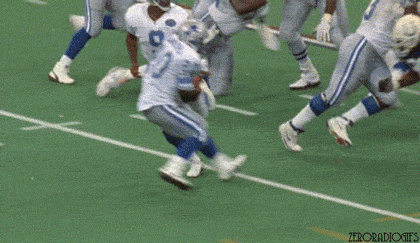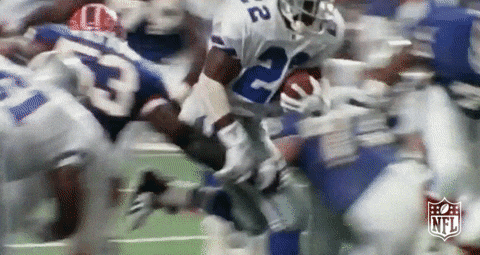4 Best Exercises For Running Back Training
FREE FOOTBALL
STRENGTH WORKOUT!
Download by entering below

4 Best Exercises For Running Back Training
Talking about strength training for running backs we need to think of all the various problems running backs may have to execute on the field. Running backs need to be able to hit a hole very quickly. They also need to have the strength to take on an opponent, like a powerhouse linebacker, monster defensive tackle, or a defensive back coming off the edge.
Running backs have a lot of different issues that come into play. They need to be agile; they also have the capability to accelerate rapidly. On top of that, running backs need good grip strength and upper body strength to prevent fumbles from occurring.
There are a lot of different problems running backs have. Thinking about this as a strength coach, football coach, or athlete, we need to think about how all these different factors mesh together to work synergistically.
The first two exercise we need to mold together ...
1. Unilateral Upper-Body Strength
To create an elite running back, we need to understand how unilateral upper-body strength and dynamic trunk control play off of each other.
Think about a running back hitting a huge stiff arm. The athlete having the ball in one hand and has an opponent coming into them, hitting the stiff arm is a unilateral position. It is one arm throwing a blow. At the same time, the other arm in elbow flexion is controlling the football with a solid grip. There is sort of a push and a pull transpiring. It can also be thought about when a running back chips a defensive end before heading out into the flat for a pass reception. This means that on-the-field running backs will use aspects of unilateral upper-body strength while running the ball and blocking.
2. Dynamic Trunk Control
There are a few key factors to dynamic trunk control. Athletes need really good strength in their core, their trunk, and all throughout the back. Their erectors are strong, the gut is strong, and the athlete knows how to absorb force from real heavy cleans, controlling loads from a back squat perspective, front squat perspective, and single-leg squat perspective. The athlete can take their dynamic trunk control, being more rigid in the gut and back, throwing that nasty stiff-arm now has a more solid foundation to punish the tackler and make their job difficult.
Creating tremendous tension through the core, through the abs, through the back, leads to force production for unilateral upper-body strength. Athletes in the weight room can perform stiff-arm lock-out dumbbell benches, alternating dumbbell benches, or push-ups to an explosive hold on one arm. Getting into dynamic trunk control, athletes can perform snatches, cleans, front squats, single-leg squats, and any and all various movements that lead to improved dynamic trunk control.
One key factor with DTC is thinking about super-shifty running backs. Think of an athlete like Barry Sanders. Dynamic trunk control is the idea of running full speed, throwing on the breaks, plant on the right leg, and cut to the left, and instead of the upper body continuing forward, the DTC optimized from the strength training helps the body to change directions and cut more rapidly. DTC plays into how well the running-back cuts and accelerates out of the cut, helping with shiftiness.

We want to hit at least two exercises a workout that hit the DTC.
3. Max Strength
At Garage Strength, we believe max strength is overlooked when dealing with running backs. People always think about linemen when it comes to maximal strength. But running backs at the elite level know they have to be superb blockers. They need to be able to put the anchor down and meet an opponent running full speed at them. The running back’s strength plays a role in preventing the defender from getting to the QB. The strength of an athlete’s back squat, bench press, and the strength of their clean comes into play.
Think about a running back hitting the hole and needing two more yards to get the first down. That beast defensive tackle is meeting the running back right in the hole and trying to drag them down. With solid unilateral and bilateral strength, the running back can drag the defender holding onto the legs to get the yards needed.

Exercises that help improve maximal strength in the weight room can come about by performing single-leg squats, back squats, front squats, step-ups, really, really heavy sled pulls, and really, really heavy sled pushes. These are some key movements that lead to maximal strength and contribute to improving play on the field.
4. Acceleration Work
Football is all about acceleration. Running backs have to have a really good start as the play begins. They have to have an explosive period of acceleration. Ninety to ninety-five percent of a football game running backs are played in acceleration. It is very rare that running backs are at their top-end speed.
It is all about acceleration. We need to think about having a forward lean from the torso and, most importantly, a steep shin angle. A steep shin angle means quad-based and glute-based actions. This means running backs need to have mobile ankles, the shin being forward so the athlete can train in that range to light up the quads and light up the glutes. The glutes are the biggest muscle on the entire body.
We have to do a lot of work on acceleration. This might mean single-leg jumps from a Gwiz start position; banded work from a skater squat into a snatch hip lock; doing single-leg work, like single-leg squats; faster sled pulls or hill work. All of this stuff comes into play.
Recap
Understanding how to put this all together is important. Uniting the unilateral upper-body strength with DTC is important. The cool thing about DTC is it can be hit with max strength work and acceleration work. By doing all of this work, the running back will be able to start to run rampant. Do the squats, train the core, and build explosive capabilities to better accelerate and dominate on the field.
Related Posts
Blog Topics

Yo, It's Dane
Welcome to the Garage Strength Blog, where it is my goal to provide you with the experience and knowledge I've gained in the strength and conditioning world over many years of learning from both successes and failures. I train elite-level athletes in a multitude of sports from the high school to professional levels, already producing 5 Olympics and 30+ National Champions. If you want to be the next champion I train, check out my strength programs below!
Start Training With Me

Join for free educational videos EVERY WEEK on strength coaching and athletic performance



